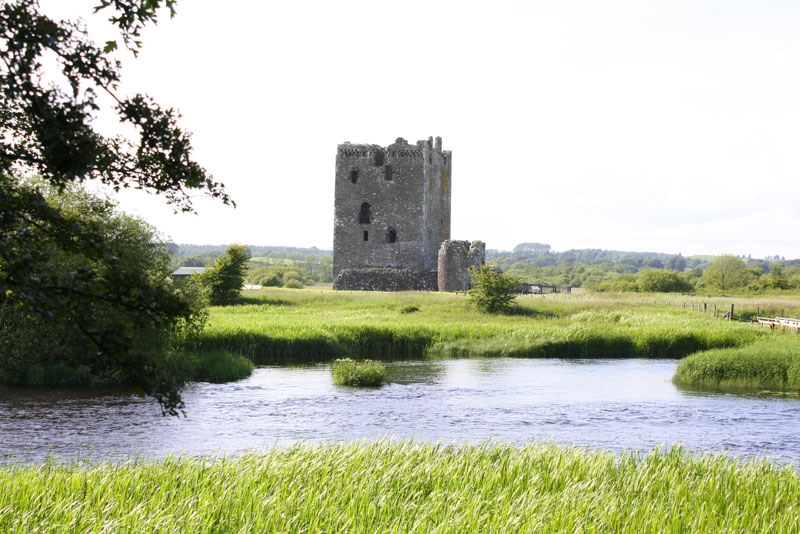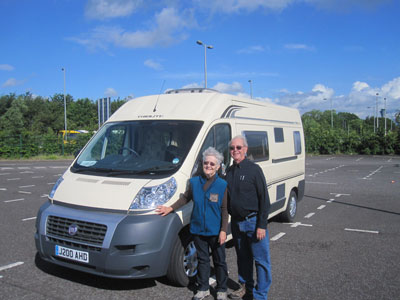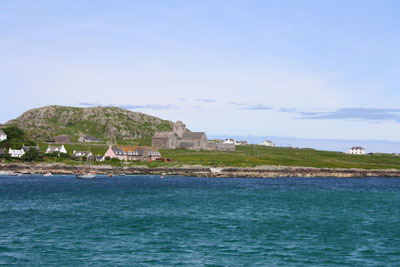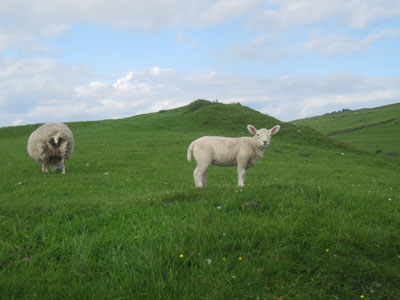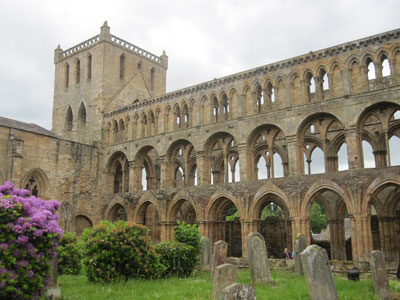Life on wheels – a motorhome journey through Scotland
This article appears on page 20 of the November 2014 issue.
by John Graham; Granite Bay, CA
In 1984 my wife, Margaret, and I and our two little boys, ages two and five, moved to London after the company I worked for offered me a job there. During the nine years we lived there we made many trips throughout the United Kingdom, including one long trip through the Western Isles and Highlands of Scotland in our VW campervan.
Since the kids are now grown and we’ve retired, Margaret and I decided to return to Scotland to repeat that memorial trip.
Getting settled
In June 2014 we flew into Edinburgh, where we hired a motorhome from Atlas Motorhome & Camper Van Hire (Glasgow, Scotland; phone +44 141 416 2773, www.atlashiredrive.co.uk). We found a number of different companies that rent motorhomes in Scotland (search “motorhomes for hire in Scotland”) but chose Atlas because their terms of hire seemed more straightforward and inclusive and because their motorhomes were not plastered with advertising.
We rented a luxury 2-berth campervan for 17 days at a total cost of $3,600, which included linens and camper delivery and return in Edinburgh.
The motorhome was a full-sized Fiat Ducato van conversion with a 6-speed manual transmission and a diesel engine. It was completely equipped with a gas stove and oven, refrigerator and freezer, bathroom, kitchen utensils, kettle, TV/DVR, cleaning supplies and both road and camping maps.
The couch unfolded into a double bed that was snug but comfortable for us.
We knew that our flight from our home in northern California would be tiring, with stops in Los Angeles and London before we finally landed in Edinburgh, so I booked a room for two nights at the Hilton Edinburgh Airport Hotel (phone +44 131 519 4400) so that we would be rested and ready for the challenges of driving and navigating.
The Hilton is a 10-minute walk from the airport and, although expensive at more than $250 per night, it was convenient. We enjoyed some of the friendliest hotel staff we’ve ever encountered.
The new Edinburgh Tram started service just a few days before our arrival and it made getting into the city of Edinburgh a very easy and pleasant 40-minute ride (about $27 for the two of us).
We enjoyed a day in Edinburgh walking up and down the streets, doing a little shopping and getting adjusted. Our first stop was the VisitScotland tourist information office, located in the Princes Mall, where we filled my backpack with brochures and printed guides of the different regions in Scotland. We had deliberately not “overplanned” our trip so that we would be free to explore as much or as little as we decided each day, and the guides proved to be very valuable.
Before we returned to our hotel on the tram, we enjoyed an excellent fish-and-chips lunch with local beverages at The Rosehip Restaurant & Bar (43 Rose Street), just a block up from Princes Street, for $51.
Preparing for the road
John from Atlas met us at our hotel the next morning and gave us a good orientation to our rented motorhome. Everything was as advertised and in good working order.
After a couple of laps around the parking lot to get a feel for the 6-speed manual transmission and for driving on the left side of the road, we made our first stop at a very large Morrisons supermarket.
When we were last in Scotland, the stores we saw were small, with short hours, and generally were closed on Sundays. Things have really changed! Morrisons — like Tesco, Sainsbury’s or Asda, the major markets in the UK — is as large as or larger than most American supermarkets, stocks an international selection of foods (craving Old El Paso-brand fajitas?) and was open from 8 a.m. to 10 p.m. every day of the week.
On Sunday morning, we had the store to ourselves as we wandered up and down the aisles. We stocked up on essentials like bread, butter, jelly, cheese, locally brewed libations and several prepared meals, in case we couldn’t find a local restaurant or pub on our travels.
The motorhome did not have a coffeemaker, so we bought a package of “one-cup filters,” plastic filters containing coffee grounds. Each individual filter sits on a coffee cup and, when filled with boiling water, gives you an excellent, freshly brewed cup of coffee.
We hopped on the motorway under sunny skies and headed southeast to the Borders area. We tried to drive the secondary roads to see the countryside, and this first day was beautiful. The fields were brilliant shades of green, with cows and sheep contentedly grazing.
Heading out
One of the joys of setting your own schedule and itinerary is the ability to stop whenever you feel like it. One of our first stops was the Caldwell’s Luxury Ice Cream shop on the High Street in Innerleithen, where Margaret enjoyed a rhubarb crumble and I had a raspberry swirl.
We drove almost 1,500 miles in our motorhome over our 17 days on the road. From the Borders, we dropped down into northern England to see the ruins of Hadrian’s Wall, then headed west and north back into Scotland and the market town of Moffat. Continuing west through Dumfries and along the coast to Ardrossan, we caught the Caledonian MacBrayne ferry to the island of Arran.
We had wanted to continue to the island of Islay, but the ferry was booked solid. True to our motto of “Be flexible,” we continued north to the port city of Oban.
From there, the ferry to the island of Mull again had no space for our motorhome, so the Caledonian MacBrayne agent suggested one of their day tours to Mull and the small island of Iona. This turned out to be one of the highlights of our trip and, at only $136 for the two of us, a real bargain.
As foot passengers, we had no trouble getting ferry tickets. We were met by a very comfortable tour coach at the dock on Mull and had a most interesting guided tour across the island under gorgeous sunny skies, followed by a 10-minute ferry ride to Iona.
St. Columba introduced Christianity to Scotland in 563 when he established a monastery on Iona. Today, there is a very small village on the island plus the ruins of a nunnery and the abbey that was built later on the site of the monastery.
We had a delightful walk and enjoyed the sea, the sun and the historic sites. We were glad that we had taken our own lunch, since there were only a few small places to eat.
We had a good ride back to the dock in Mull and were back in Oban for dinner.
The next day we bought a Caledonian MacBrayne Hopscotch ticket to the Outer Hebrides, leaving Oban for the island of Barra. The ticket, $425 for the motorhome and two passengers, included the ferry rides from Barra to South Uist, North Uist to Harris and, finally, Stornoway, on the island of Lewis, back to the mainland at Ullapool. We rode the ferries between the islands and leisurely explored the Outer Hebrides.
From Ullapool, we zigzagged across the Highlands; camped at Loch Ness; toured four different Scotch whisky distilleries; visited Stirling Castle, the ancient home of Scottish royalty, on the 700th anniversary of the Battle of Bannockburn, and finished back in Edinburgh with a visit to a very crowded Edinburgh Castle.
Driving details
The people in Scotland were all very friendly, welcoming and helpful.
The exchange rate of $1.70 per £1 was painful and made this trip a wee bit expensive. I had a MasterCard from USAA Federal Savings Bank with an embedded chip and used it everywhere with no problems. I used my debit card with a magnetic strip at ATMs and for one purchase without trouble.
Driving the motorhome was an experience. It was 30% longer and 15% wider than the typical midsize car in Scotland and would not fit in a standard parking spot. With the steering wheel on the right side, driving on the left side of the road was easier, and I had learned to drive with a stick shift, so the clutch and 6-speed transmission weren’t difficult, but there were times — in heavy traffic, going around a roundabout, shifting up and down and looking for road signs while it was lightly raining, all at the same time — that made it challenging.
Driving on the single-track roads in the Western Isles and Highlands was easy, since there was little traffic. There were turnouts or passing places every few hundred yards so vehicles could get off the road to let oncoming traffic pass. Since ours was so much bigger than most of the other vehicles, they usually pulled off first and let me pass!
Driving on the very narrow, twisty and hilly 2-lane country roads required all of my attention, since I never knew when I might meet an oncoming bus or truck coming around a bend in the road.
We tried to plan our route each morning, but more than once we explored some unplanned roads that allowed us to see hidden parts of the country. And, just to make life a bit more interesting, the signs in the Western Isles and Highlands are in Gaelic, with small English subtitles.
The 6-speed manual transmission and diesel engine made the motorhome fuel efficient. We averaged just over 26 miles per US gallon; the price per US gallon was about $8.70.
Camping stops
We were able to find campgrounds/caravan parks everywhere we went, but it helped to have the camping map that Atlas provided. Almost all camping areas were signposted on the main roads — even the one that took us eight miles up and down the mountainside on a single-track road that we had to share with both sheep and cows (but no other cars).
The campgrounds all were privately owned, and every one had a separate toilet facility with private hot showers; a kitchen area to prepare meals and clean up; washers and dryers; trash cans; disposal stations for chemical toilets and greywater, and available fresh water. Hookups provided only 240V electricity. All the facilities at every campground were spotlessly clean.
The prices ranged from about $17 for a site without electricity to $44 per night at a major park close to Edinburgh. (The average for a site with electricity was about $35 per night.)
We learned to find a place for the night by 6 p.m., since the parks filled up, even though it was not yet in high season (July-August).
We had a wonderful trip and wished we could have continued to tour for the rest of the summer. If you have any questions about this trip, please feel free to contact me (grahamjohnj3@gmail.com).

